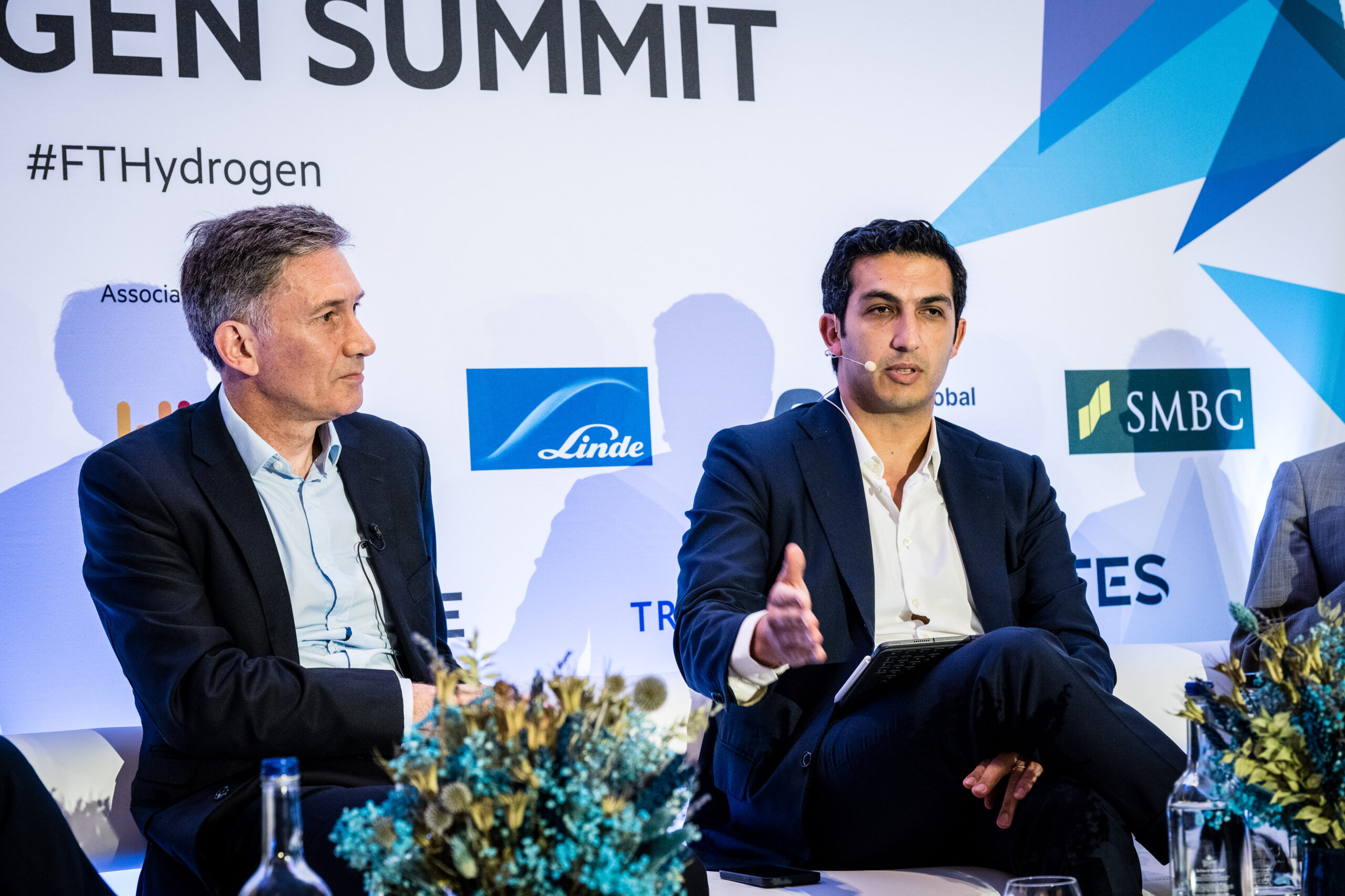The global shipping industry is under increasing pressure. With growing scrutiny from customers looking to decarbonize their entire supply chains and increasing regulation, the industry needs to find cleaner fuel solutions fast.
Earlier this month, OCI Global announced we are fueling the world’s first ever green methanol container ship with Maersk, building on the momentum of our partnership with Unibarge earlier this year to develop Europe’s first dual-fueled green methanol bunker barge.
While these are important milestones for the maritime industry, much more needs to be done to decarbonize an industry that is responsible for 3% of global greenhouse gas emissions.
On a panel at the FT Hydrogen Summit, with co-panelists Alicia Eastman, Christopher J. Wiernicki, Adam Forsyth, our CEO Ahmed El-Hoshy debated what those solutions are, including the promising progress made already through the use of green methanol, and the future potential of ammonia as a clean fuel.
An evolving regulatory landscape
The regulatory landscape is becoming increasingly stringent, with clear targets and measures aimed at reducing GHG emissions from the shipping industry:
- The International Maritime Organization (IMO) has set ambitious targets for greenhouse gas (GHG) emissions reductions in the shipping industry. These targets include cutting annual emissions by at least half compared to 2008 levels by 2025, and working towards phasing out GHG emissions entirely.
- To achieve this goal, the IMO envisions a reduction in carbon intensity by at least 40% by 2030 and 70% by 2050 across international shipping.
- The IMO’s upcoming meeting in July will further discuss an international carbon levy, with an updated strategy to be published later this year.
- The FuelEU Reduction Targets set benchmarks for well-to-wake GHG emissions reductions for all ships calling at European ports from 2026 onwards.
- The extension of the Emission Trading System (ETS) to maritime activities starting in 2026 will further drive emissions reductions and encourage the industry to explore greener alternatives.
As a result of these and other policies, ship operators, port authorities and fuel producers are feeling the pressure to adapt and implement sustainable practices, explore low-carbon fuels, and invest in efficient technologies.
Green methanol is ready for shipping today
Green methanol has emerged as the undisputed frontrunner for maritime fuel, offering a readily available and scalable solution. Green methanol is methanol produced from renewable feedstocks including hydrogen and biomethane. The advantages of methanol are numerous:
- As a liquid, it is easier, safer and cheaper to store, transport and handle as existing infrastructure can be used
- It is a clean-burning fuel that has less and non-toxic emissions,
- It has an energy density three times higher than compressed hydrogen, meaning it offers high efficiency and can be used in internal combustion engines or fuel cells.
It is clear that the industry is already embracing methanol as its near-future solution. The demand for methanol-powered vessels is anticipated to accelerate significantly, especially from the latter half of this year and leading shipping companies like Maersk and CMA CGM have endorsed the adoption of green methanol as a viable and impactful solution.
Ammonia: An exciting longer-term solution
While methanol is the leading option today, ammonia – a clean burning fuel- is a critical future solution for shipping. As well as offering zero-carbon emissions, ammonia is easy to produce, has a high energy density, and is versatile for use in internal combustion engines or fuel cells.
However, there is still work to do to make it scalable:
- Safety is an important factor. Existing ammonia players like OCI Global, with our expertise in handling ammonia and operating vessels, such as LPG/Gas Carriers, play a crucial role in this regard.
- Infrastructure needs to be developed –We are currently tripling our throughput at the Port of Rotterdam, where we have the port’s only ammonia import terminal, but we need other companies to join us in investing in the necessary infrastructure to make ammonia a realistic global solution.
While widespread implementation is more likely to occur after 2040, significant volumes of ammonia are expected to be seen in the next decade. Industry forecasts indicate a strong role for ammonia in decarbonizing the maritime energy mix by 2050. Major ports like Singapore are already actively focusing on ammonia bunkering and collaborating with industry consortia to study its feasibility and accelerate its deployment. At the same time, efforts are being made to establish safety and operational guidelines, build infrastructure, and create green and digital shipping corridors.
There’s no single solution
Decarbonization is a complex challenge, and there’s no single solution for any industry. The maritime industry is already embracing a range of options – the discussion at the FT Hydrogen Summit panel was so lively we barely had a chance to discuss LNG or E-LNG – and it’s encouraging to see that progress is being made towards scaling both methanol and ammonia as future shipping fuels.
Ultimately – more still needs to be done. We need to kickstart regulation and incentivization, take ownership and leadership of investing in infrastructure, work closely with partners across the shipping ecosystem, ensure stringent safety frameworks are being implemented, and scale up the necessary technologies. By bringing together producers, regulators, investors, infrastructure developers and industry leaders, the FT Hydrogen Summit helped foster some of the important conversations that need to be had, and we look forward to working closely with the industry as we continue to power a cleaner future sooner.

